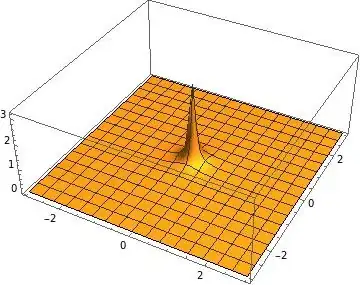I started with the following limit representation of the Dirac delta function:
$$\delta (x)=\underset{\epsilon\to 0}{\text{lim}}\left(\frac{\epsilon}{\pi\,\left(x^2+\epsilon^2\right)}\right),\quad x\in\mathbb{R}\tag{1}$$
Figure (1) below illustrates $\delta (x)$ defined in formula (1) above evaluated at $\epsilon=0.1$
Figure (1): Illustration of formula (1) for $\delta (x)$ evaluated at $\epsilon=0.1$.
I then attempted to extend the limit representation of $\delta(x)$ defined in formula (1) above to the complex plane as follows:
$$\delta(s)=\underset{\epsilon\to 0}{\text{lim}}\left(\frac{\epsilon}{\pi\,\left(s\,s^*+\epsilon^2\right)}\right),\quad s\in\mathbb{C}\tag{2}$$
Figure (2) below illustrates $\delta (s)$ defined in formula (2) above evaluated for $s\in\mathbb{C}$ using $\epsilon=0.1$.
Figure (2): Illustration of formula (2) for $\delta (s)$ evaluated over the complex plane using $\epsilon=0.1$
Now consider the following integral of $\delta(s)$ defined in formula (2) above along the line $s=(a+i\,b)\,t$ where $a,b\in\mathbb{R}\land a^2+b^2=1$:
$$\int\limits_{-\infty}^\infty \delta((a+i\,b)\,t)\,\,dt=1\,,\quad a,b\in\mathbb{R}\land a^2+b^2=1\tag{3}$$
Integrating along the lines $s=t$ (where $a=1$ and $b=0$) and $s=i\,t$ (where $a=0$ and $b=1$) obviously meet the condition $a^2+b^2=1$ specified in formula (3) above. For the case $a\,b\ne 0$, if the line $s=(a+i\,b)\,t$ passes through the point $(c,i\,d)$ as well as the origin, then $a$ and $b$ can be calculated as
$$a=\frac{c}{d} \sqrt{\frac{1}{\frac{c^2}{d^2}+1}}\tag{4}$$
$$b=\sqrt{\frac{1}{\frac{c^2}{d^2}+1}}\tag{5}$$
or alternatively as
$$a=\sqrt{\frac{1}{\frac{d^2}{c^2}+1}}\tag{6}$$
$$b=\frac{d}{c} \sqrt{\frac{1}{\frac{d^2}{c^2}+1}}\tag{7}$$
Question: Can the Dirac delta function $\delta(x)$ for $x\in\mathbb{R}$ be extended to $\delta(s)$ for $s\in\mathbb{C}$ at least when integrated along the line $s=(a+i\,b)\,t$ where $a,b\in\mathbb{R}\land a^2+b^2=1$ as illustrated in formula (3) above?

